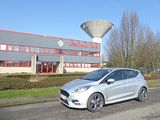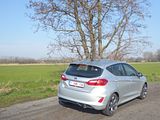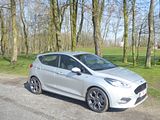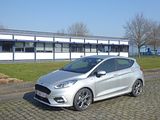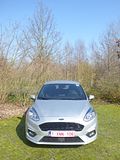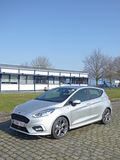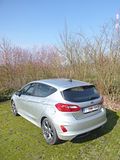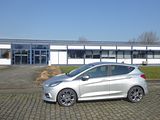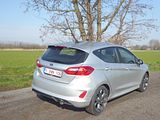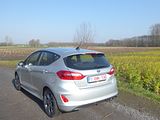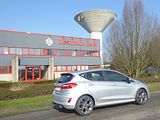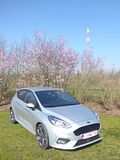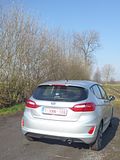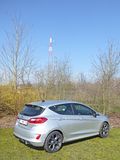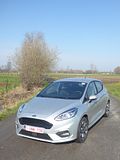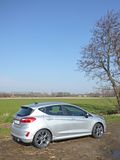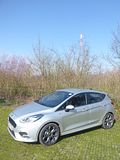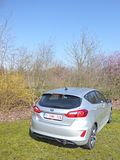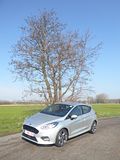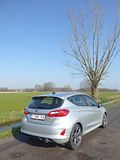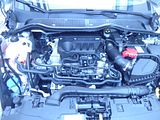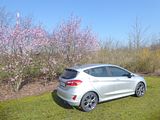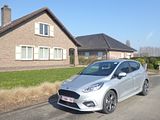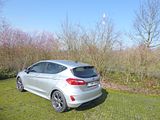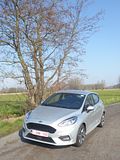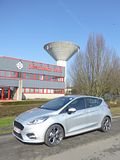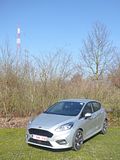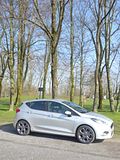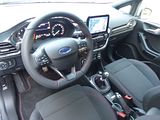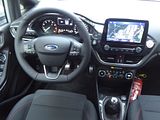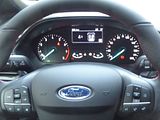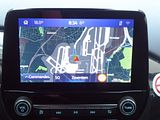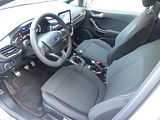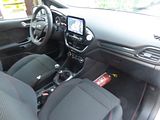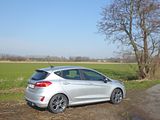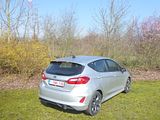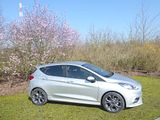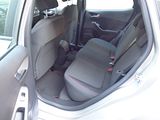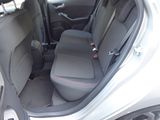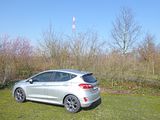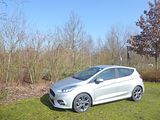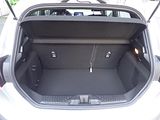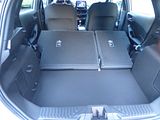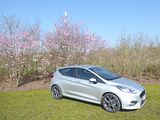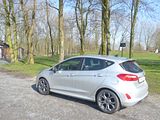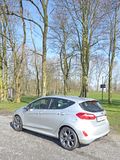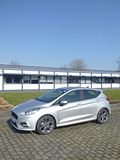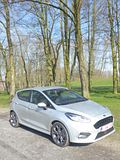No question, Ford’s Fiesta has been a huge success. First seen in 1976, it was the Blue Oval’s first front wheel drive car and first supermini-sized hatchback, at a time when neither of these formats were anything like as ubiquitous as they are now, although it was clear that this was the way the market was heading. That first car did not change much for seven years, and the facelifted model lived on a further six years after that, but ever since the rate of change has been faster, with new body styles and mid-cycle updates appearing on a frequent basis. By 2017, at the time of the launch of the seventh generation of the Fiesta, over 17 million had been produced, with 4.5 million of them having found homes in the UK. The sixth generation car was really quite different from its predecessor, trading style over the ultimate internal space and blessed with the Richard Parry-Jones touch which had made it particularly sparkling on the road, with class-leading steering and handling. The formula worked, and sales were strong, so it was perhaps no surprise that the new seventh generation did not, at first glance, appear to deviate much from the car was replacing. Indeed, at that first glance, especially from the front, the two were not that easy to tell apart. Of course, just about everything had actually been changed with only 200 of the 2500 parts that go into a Fiesta being carried over. The new model was changed in every dimension, being 70mm longer, 13mm wider but 20mm lower, and had completely new suspension and was designed to include all the latest safety systems as well as the sort of technology and sophistication that buyers expect event at this point in the market. Sales continued to be strong. It used to be the case that the was also the doyen of the rental fleets, certainly in the UK, but that is no longer the case and so, nearly two years after the model went on sale, I still had not driven one. The chance to rectify that came from Hertz Belgium who allocated one to me for a weekend rental that I made when where I needed a car to get from Brussels to Antwerp for a car show I wanted to attend, as well as some general sight-seeing in the area.
The Fiesta is offered with a wide range of engines, both petrol and diesel, and there’s a wide spread between the power output from the bottom to the top of the range. They are all three cylinder units. Entry level models come with a 1.1 litre 85 PS engine but by far the most popular are the 1.0 litre Ecoboost cars, which are available with three different outputs from the same engine: 100, 125 and 140 PS. Top of the petrol models is the potent ST with 200PS. There is also a 1.5 litre diesel, available with two different power outputs, 85 and 120 bhp. Entry level cars have a five speed manual, all the others have a six speed as standard and there is the option of an automatic only in combination with the 100 PS engine. My test car had what is probably the most popular choice, and by all accounts, possible the best one as well, the 100PS 1.0 litre Ecoboost. No question this is a good engine. It always feels eager, revving freely and there is a very purposeful note to it, in a good way. Like almost all modern petrol units, you will need to use the gears a lot to get the best out of it, but that is no real hardship as the lever slots very cleanly between the six forward ratios and actually this adds somewhat to the sense of fund that you get from driving the Fiesta. 100 PS is enough to make the car feel quite nippy and there is strong acceleration once the turbo gets really busy. There is no penalty at the fuel pump for enjoying the car, either. I covered a slightly surprising 542 km in my weekend with the car and it needed 35.3 litres to refill it, which works out at 43. 56mpg, which is a decent result. There is a standard stop/start system to help if you are doing lots of urban motoring.
This Fiesta continues where its predecessor left off in being probably the most enjoyable car in its class to drive. That is thanks to the excellence of the steering and handling. Tempting though it may have been to leave well alone, Ford actually completely redesigned the suspension for this generation, aimed at making it even better. Whilst the electric system that is used these days might not be quite as good as previous mechanical set-ups, it is still pretty good, with lots of feel, and perfect weighting. Combine that with a well-tuned chassis which endows the Fiesta with excellent handling and great levels of grip and this is a car that you can hustle along the road feeling very safe and having plenty of fun, even at relatively moderate speeds. The ST-line version has slightly stiffer suspension and sits on larger 205/45 R17s, but the ride was still very well judged, at least on Belgian roads, being just firm enough for great body control, but not too firm as to be uncomfortable. The Fiesta seemed equally able to deal with speed bumps and potholes at low speeds just as well as it dealt with motorway expansion joints at much higher speeds, giving the Fiesta a sense of solidity and big car refinement. The brakes are well up to the job in stopping the car. Pleasingly, you still get a conventional pull-up handbrake between the seats. Not quite so impressive are the noise levels. There was really quite a lot of wind noise, but it was a windy day when I was driving the car the furthest and there is also quite a lot of road noise on some surfaces. The engine note is well supressed when at a steady speed. The Fiesta is, by modern standards, still quite a small car, and as such it is easy to manoeuvre. Visibility is about class average, though nothing like as good as used to be the case, with thick pillars and those small third windows on the side not helping matters. There are rear parking sensors. Like many Fords, you get a heated front screen, which can be a real boon in cold starts but the downside is that heating elements are visible sometimes. The Fiesta has the full complement of modern safety features and it is worth noting that the Lane Departure Warning and Lane Keep Assist here were less annoying than is the case with some cars.
It was the interior, both in design and quality terms, that really let the last generation Fiesta down. This one is a noticeable improvement, though it is still not exactly a class-leader. The materials used are much better both to look at and to touch, with plenty of softer surfaces, and the overall design has been simplified somewhat with a reduction from the excess of buttons that used to feature. It is not all good news, though, as the dash does not exactly flow into the door casings, so it still looks a bit less cohesive a design than in most rivals and there are some rather nasty hard plastics still used for the door casings. There are leather-wrapped steering wheel and gearlever knob and both proved pleasant to hold. The Fiesta follows current form with an instrument cluster which has two large dials for the speedo and rev counter and smaller ones for fuel level and water temperature set between them, along with the digital display area for trip computer functions. The dials have the turquoise pointers that you find in most Ford cars at present. You can cycle between the trip computer displays with buttons on the right hand steering wheel spoke. The rest of the setup is pretty conventional, too. The light switch is on the dash and there is an auto function. Twin column stalks operate indicators and lights and there are buttons on the steering wheel for audio repeaters ad cruise control. The infotainment touch screen is up high in the centre of the dash in free-standing form at the top of the centre console. The screen options vary depending on the model or options you choose – there are 4.2, 6.5 or, as in the case of top variants, 8.0-inch sizes, all featuring pin-sharp graphics, logical menus and fast processor speeds. Gone are all those buttons in the style of an old mobile phone that characterised the old model, as now most of the functions are touch operated though you do still get 2 knobs and search buttons for the audio element of the unit. Below this are the buttons for the climate control. There is keyless starting.
Seat upholstery is cloth and in keeping with the sporting aspirations of the ST-line model, you get some red stitching. Adjustment is all manual. There is a turn wheel for backrest adjustment which is set well back, which made it really quite awkward to reach. Duly set to where I wanted the seat and with the telescoping steering wheel also in the right place for me, the driving position was good, set quite high, but this is no bad thing as it helps with the view of what is going on all around the car. Further comfort features include height adjustable seat belts and ST-line trim of this car included both heated seats and a heated steering wheel.
All versions of this generation Fiesta come with five doors, so access to the rear is easy compared to the challenge of scrambling past a tipped forward backrest on three door versions of the old car. If you are familiar with the previous generation Fiesta, then you may see a bit of improvement in the rear passenger space, as there is indeed 16mm more knee room than there was before, plus the seats are softer and offer greater side-to-side support. However, if you are comparing the Fiesta with its many rivals, you’ll probably be a little less inclined to be quite so generous in your assessment, as space here, even allowing for the compact external dimensions of the car, can only really be described as adequate. I found my head was all but touching the rear roof-lining. There are useful pockets on the back of the seats and bins on the doors for those odds and ends.
It is the same story with the boot. The extra body length has allowed the cargo area to be 17-litres larger than it was before, rated at 292-litres for both the three and five door body syles. That figure is only average by class standards, though the available seat is quite deep. If you’re able to flatten the 60:40 split-folding rear backrest, you’ll free up one of the better total capacity figures in the class – 1,093-litres, though the load area is not flat from end to end. Inside the cabin there is a good-sized glovebox, pockets on the doors and a small cubby over the driver’s left knee as well as a small cubby under the central armrest, though this is set well back and not that easy to access.
There has not been quite the proliferation of trims in this generation of the Fiesta that we have seen in the past, but even so, there are plenty and when you factor in the engine choices and whether the car has a manual or the six speed auto box, then there really should be a Fiesta for everyone. At launch, the range started with the Style, followed by the Zetec but these were consolidated into a single version in mid 2019 called the Trend which is now the entry level spec. Sitting above this are Titanium and Titanium X, ST-Line and ST-Line X, the posh and slightly pretentious Vignale and finally the real-deal ST. For those who want the faux off-roader look, which it seems a surprising number of people do, as various rivals offer something similar, there is the Fiesta Active. Gone are the days when the entry level model is a stripped out economy special as was the case with the Fiesta Popular of the early 1980s, as even the Trend comes with quite an extensive kit list. When launched, Ford said that they expected it to account for around 40% of all Fiesta sales, and that has been borne out in the market. Standard exterior features include 16-inch silver and black machined alloy wheels, privacy glass and six metallic body colours plus a mesh design front grille with chrome surround and halogen projector headlamps with daytime running lights. As well as SYNC infotainment and connectivity inside, lane keeping aid, speed limiter, auto head lamps, MyKey also come as standard. MyKey enables top speed, maximum audio volume and other settings to be limited for when the car is driven using the second “MyKey”. Titanium adds cruise control, automatic lights and wipers and climate control, rear privacy glass and some extra chrome trim and there was also a B&O Titanium (there was also a B&O Zetec) version with an upgraded 10-speaker 675-watt sound system. Titanium X gets the B&O sound system as standard along with heated front seats and steering wheel. The Fiesta ST-Line features sporty exterior styling including unique alloy wheel, grille, front and rear bumper and side-skirt designs. The interior features sports seats, alloy pedals and a flat-bottomed steering wheel, while the driving experience is enhanced with sports suspension but as far as other standard features are concerned, this was broadly the same as the Titanium. To this, the ST-Line X adds LED rear lights, automatic lights, wipers and high beam assist, cruise control, half-leather seats, and the SYNC 3 infotainment. The Fiesta Vignale offers model-specific 17-inch alloy wheels, unique exterior body styling and front grille with a distinctive interior in Black Ruby leather, with hexagonal-quilted, tuxedo-stitched heated seats and a leather-wrapped steering wheel, panoramic roof and a rearview camera as standard as well as all the marketing-led nonsense that Ford have promulgated about the Vignale experience. It comes with what many feel is quite a hefty price tag, but surprisingly, quite a few have decided to pay it. The Fiesta Active is the first Fiesta crossover model, combining rugged SUV-inspired styling that includes raised ride-height, roof bars and additional exterior bodystyling; hatchback practicality; and true Fiesta driving dynamics.
No question, the latest Fiesta is a good car and thorough deserves it sales success. The seventh generation has addressed one of the few weaknesses of the older car, the sub-par interior quality, and it has lost none of the sparkle that made the car so good to drive. What has not been fixed, though, is making it stand out as a roomy car by class standards. Whether this matters or not will depend on how often you expect to use the rear seats and boot. Ford’s researches that led to the sixth generation giving this less of a priority than had been the case with the much boxier 2001 model suggested that for plenty of people it was not the most important attribute and they did no change course for this generation. In any case, the Fiesta is not lacking, it is just that there are more spacious rivals on offer if you really want. That aside, the Fiesta wants for nothing much, looking neat, being well equipped even in entry level models, and being relatively cheap to run. It’s not hard to see why it continues to be such a sales success, having been Britain’s best seller for many years now.


